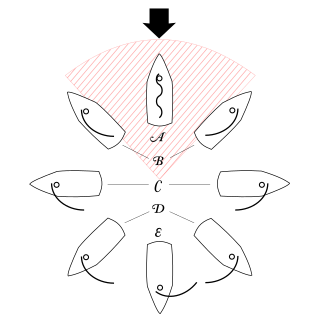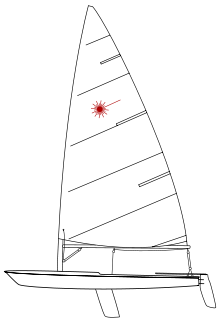
A hull is the watertight body of a ship, boat, or flying boat. The hull may open at the top, or it may be fully or partially covered with a deck. Atop the deck may be a deckhouse and other superstructures, such as a funnel, derrick, or mast. The line where the hull meets the water surface is called the waterline.

Sailing employs the wind—acting on sails, wingsails or kites—to propel a craft on the surface of the water, on ice (iceboat) or on land over a chosen course, which is often part of a larger plan of navigation.

A sailboat or sailing boat is a boat propelled partly or entirely by sails and is smaller than a sailing ship. Distinctions in what constitutes a sailing boat and ship vary by region and maritime culture.

The keel is the bottom-most longitudinal structural element on a watercraft. On some sailboats, it may have a hydrodynamic and counterbalancing purpose, as well. The laying of the keel is often the initial step in the construction of a ship. In the British and American shipbuilding traditions, this event marks the beginning date of a ship's construction.

A point of sail is a sailing craft's direction of travel under sail in relation to the true wind direction over the surface.

A centreboard or centerboard (US) is a retractable hull appendage which pivots out of a slot in the hull of a sailboat, known as a centreboard trunk (UK) or centerboard case (US). The retractability allows the centreboard to be raised to operate in shallow waters, to move the centre of lateral resistance, to reduce drag when the full area of the centreboard is not needed, or when removing the boat from the water, as when trailering. A centreboard which consists of solely a pivoting metal plate is called a centerplate. A daggerboard is similar but slides vertically rather than pivoting.

A leeboard is a form of pivoting keel used by a sailboat largely and very often in lieu of a fixed keel. Typically mounted in pairs on each side of a hull, leeboards function much like a centreboard, allowing shallow-draft craft to ply waters fixed keel boats cannot. Only the leeward side leeboard is used at any time, as it submerges when the boat heels under the force of the wind.
A bilgeboard is a lifting foil used in a sailboat, which resembles a cross between a centerboard and a leeboard. Bilgeboards are mounted between the centerline of the boat and the sides, and are almost always asymmetric foils mounted at an angle to maximize lateral lift while minimizing drag. They are most often found on racing scows.

Hobie Cat is a company that manufactures sailing catamarans, surfboards, sailboats, kayaks, stand-up paddle boards, and pedalboards as the Hobie Cat Company. It was founded in 1961 by Hobart Alter, who originally manufactured surfboards. Its line of products has included more than twenty sailing craft, plus a variety of other watercraft.

The MacGregor Yacht Corporation was a manufacturer of sailing yachts, located in Costa Mesa, California.

A sailing hydrofoil, hydrofoil sailboat, or hydrosail is a sailboat with wing-like foils mounted under the hull. As the craft increases its speed the hydrofoils lift the hull up and out of the water, greatly reducing wetted area, resulting in decreased drag and increased speed. A sailing hydrofoil can achieve speeds exceeding double and in some cases triple the wind speed.

A trailer sailer is a type of sailboat that has been designed to be easily transported using a boat trailer towed by an automobile. They are generally larger than a sailing dinghy. Trailer sailers include day sailers and small cabin cruisers, suitable for living on.
The following outline is provided as an overview of and topical guide to sailing:
The Beachcomber 25 is an American trailerable sailboat that was designed by Walter Scott as a cruiser and first built in 1979.
The Stiletto 27 is an American trailerable catamaran sailboat that was designed by Bill Higgins and Don Ansley as a racer/cruiser and first built in 1976.
The Cheshire 14 is an American catamaran sailing dinghy that was designed by Frank Meldau as a racer and first built in 1962.
The Phantom 14, also called the Phantom 14', is an Italian catamaran sailing dinghy that was first built in 1995.
The Phantom 16, also called the Phantom 16', is an Italian catamaran sailing dinghy that was first built in 1988.
The Prindle 18 is an American catamaran sailing dinghy that was designed by Geoffrey Prindle as a racer and first built in 1977.
The Neptune 24 is an American trailerable sailboat that was designed as a cruiser and first built in 1978.














